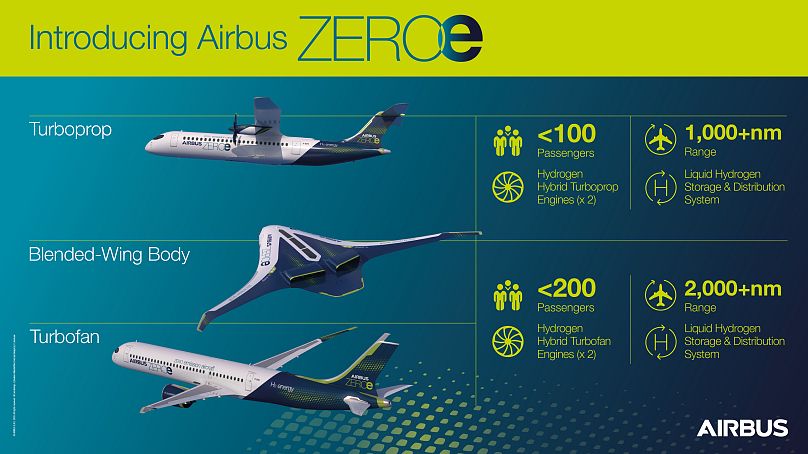A global challenge
The journey to launch the world’s first zero-emission commercial aircraft began with a belief that aviation, like other industries, must transform if it’s to remain strong and relevant in decades to come.
To reach net zero, enormous technological, structural and business challenges impacting the entire value chain - from energy generation to airport design - must be overcome. Yet just as the automobile industry is rapidly transitioning from fossil fuels to electric energy, the transition in aviation is well underway and momentum is building amongst airlines, manufacturers and governments.
A sustainable industry needs coordination and cooperation from all players of the global ecosystem and Airbus, a leader in aviation, is playing its part by championing change. Guillaume Faury, Airbus’s CEO spoke about the imperative of working together at the recent Airbus Summit in Toulouse.
"It's a global challenge. Aviation is a global sector. We believe we need at least the US, Europe and China to have a critical mass to create that level playing field for transforming at the right pace and the right speed. Our commitment will help other sectors like energy to do the right things for us," he said.
Short-term: More cleaner fuels
Airbus is working with partners to increase the use of Sustainable Aviation Fuels (SAFs) which are cleaner alternatives to kerosene or jet fuel. SAFs are made from forestry or agricultural waste making them more sustainable than traditional jet fuels. While Airbus aircraft are currently certified to fly with 50% SAF and this will reach 100% within the decade, the fuel represents less than one per cent of the industry’s usage.
This comes down to supply and demand. If more airlines commit to replacing jet fuels with SAFs, energy companies will increase production making it more economically competitive with standard jet fuels. Governments can also help by incentivising companies with favourable policies that reward the use of using cleaner fuels.
Longer-term: Hydrogen propulsion system
For a longer-term sustainability solution, Airbus is developing deep technologies and advocating cleaner energies that revolutise aviation as we know it. Hydrogen, a gas which turns to liquid in below freezing temperatures, has the potential to reduce aviation’s CO2 emissions by up to 50 per cent.
“I strongly believe that the use of hydrogen – both in synthetic fuels and as a primary power source for commercial aircraft – has the potential to significantly reduce aviation's climate impact,” Guillaume Faury, Airbus’s CEO said in a statement announcing the company’s three zero emission aircraft concepts in September 2020.
Hydrogen is a versatile energy source. It can power modified gas turbines through combustion, as well as act as an energy carrier by converting fuel cells into electric energy. It can also be used with oxygen to make synthetic kerosene, a cleaner alternative to jet fuel.
US banker Morgan Stanley said recently the cost of green hydrogen (hydrogen made through green energy) will fall to that of grey hydrogen (hydrogen made through coal) energy in the next few years, making the cost of renewable energy compared to fossil fuels. However, whilst hydrogen is a promising long-term energy solution, storing it creates significant technical challenges.
New machines to support hydrogen: ZEROe concept aircraft
Hydrogen gas is four times more volumic than kerosene (energy currently used) and to convert and keep hydrogen in liquid form, it needs to be stored at -253°C during flight. Planes not only need newly designed engines but a whole different architecture that can safely store hydrogen onboard. In September 2020, Airbus presented a roadmap of three concept-stage aircraft with hybrid-electric propulsion systems.
“We need innovation. We don't know what the solution will look like. We need to develop, we need to do the research. And that's the phase which is going on now and that's why we are at high speed,” Mr Faury said about the technological transition to hydrogen-powered aircraft.
The three models include:
Turbofan: This model looks very similar to what you see in the skies today. It has a range of approximately 2,000 nautical miles and can hold between 120-200 passengers. The plane is powered by hydrogen hybrid turbofans.
Turboprop: The aircraft has a capacity of up to 100 passengers and can travel for 1,000 nautical miles. It is fuelled by two hybrid hydrogen modified turboprop engines. The aircraft uses modified gas-turbine engines.
Blended wing body: This model looks the least similar to what is in the skies today because the wings merge into the main section of the plane making it triangular-like. This design allows more space to store hydrogen energy, as well as more cabin space and can carry up to 200 passengers per flight.
Airbus engineers will develop and test the different hydrogen propulsion systems and build the first demonstrators within the next five years.
Ecosystems must support the transition
Involvement from all stakeholders will help to create a global playing field that will ensure all entities - from regional airports to smaller airlines - are able to keep pace with the energy transition and remain competitive.
Airports which emit about 2-3 percent of the industry’s emissions can start using hydrogen to help decarbonise ground operations (logistics, heating, electric transportation). Investments now will help create the framework for future infrastructure, such as hydrogen refuelling tanks.
Making sustainable aviation a reality requires an enormous amount of ambition, investment and talent from all stakeholders. Airbus is proud to be at the heart of this transition, leading the way forward.
Discover the highlights of the Airbus Summit 2021



